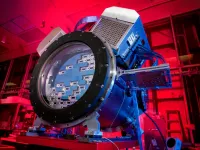Next-gen electric vehicle batteries: These are the questions we still need to answer
University of Michigan researchers lay out hurdles for tech that could double EV range
2021-05-28
(Press-News.org) The next generation of electric vehicle batteries, with greater range and improved safety, could be emerging in the form of lithium metal, solid-state technology.
But key questions about this promising power supply need to be answered before it can make the jump from the laboratory to manufacturing facilities, according to University of Michigan researchers. And with efforts to bring electric vehicles to a larger part of the population, they say, those questions need answering quickly.
Jeff Sakamoto and Neil Dasgupta, U-M associate professors of mechanical engineering, have been leading researchers on lithium metal, solid-state batteries over the past decade. In a perspective piece in the journal Joule, Sakamoto and Dasgupta lay out the main questions facing the technology. To develop the questions, they worked in close collaboration with leaders in the auto industry.
Major automakers are going all-in on electric vehicles this year, with many announcing plans to phase out internal-combustion engine cars in the coming years. Lithium-ion batteries enabled the earliest EVs and they remain the most common power supply for the latest models coming off assembly lines.
Those lithium-ion batteries are approaching their peak performance in terms of the EV range on a single charge. And they come with the need for a heavy and bulky battery management system--without which there is risk of onboard fires. By utilizing lithium metal for the battery anode along with a ceramic for the electrolyte, researchers have demonstrated the potential for doubling EV range for the same size battery while dramatically reducing the potential for fires.
"Tremendous progress in advancing lithium metal solid-state batteries was made over the last decade," Sakamoto said. "However, several challenges remain on the path to commercializing the technology, especially for EVs."
Questions that need to be answered to capitalize on that potential include:
How can we produce ceramics, which are brittle, in the massive, paper-thin sheets lithium metal batteries require?
Do lithium metal batteries' use of ceramics, which require energy to heat them up to more than 2,000 degrees Fahrenheit during manufacturing, offset their environmental benefits in electric vehicles?
Can both the ceramics and the process used to manufacture them be adapted to account for defects, such as cracking, in a way that does not force battery manufacturers and automakers to drastically revamp their operations?
A lithium metal solid-state battery would not require the heavy and bulky battery management system that lithium-ion batteries need to maintain durability and reduce the risk of fire. How will the reduction in mass and volume of the battery management system--or its removal altogether--affect performance and durability in a solid-state battery?
The lithium metal needs to be in constant contact with the ceramic electrolyte, meaning additional hardware is needed to apply pressure to maintain contact. What will the added hardware mean for battery pack performance?
Sakamoto, who has his own startup company focused on lithium metal solid-state batteries, says the technology is having a moment right now. But the enthusiasm driving the moment, he says, must not get ahead of itself.
INFORMATION:
Rigorous testing and data analysis, along with transparency in research, are needed, according to the U-M team. That group includes Michael Wang, now a postdoctoral researcher at MIT, and Eric Kazyak, a research fellow in mechanical engineering at U-M.
Images
Study abstract: Transitioning solid-state batteries from lab to market: Linking electro-chemo-mechanics with practical considerations
The Sakamoto Group
The Dasgupta Group
INFORMATION:
ELSE PRESS RELEASES FROM THIS DATE:
2021-05-28
Paper Title: Predictive Approaches for Acute Dialysis Requirement and Death in COVID-19
Journal: The Clinical Journal of the American Society of Nephrology (published online May 24, 2021)
Authors: Girish Nadkarni, MD, Associate Professor in the Department of Medicine (Nephrology), Clinical Director of the Hasso Plattner Institute for Digital Health, and Co-Chair of the Mount Sinai Clinical Intelligence Center at the Icahn School of Medicine at Mount Sinai; Lili Chan, MD, Assistant Professor in the Department of Medicine (Nephrology) at the Icahn School of Medicine at Mount Sinai; Akhil Vaid, MD, postdoctoral fellow in the ...
2021-05-28
Over half of the UK's arts and cultural venues and organisations believe they are at risk due to the decline in income during the pandemic, a new study from the University of Sheffield, University of Kent, and the Chartered Institute of Fundraising has shown.
The only study of its kind, 'Dealing with the crisis: Creativity and resilience of arts and cultural fundraisers during Covid-19' (28 May 2021), gathered information about how arts and cultural fundraisers were impacted by, and managed the Covid-19 pandemic during 2020.
Many artists, organisations and venues rely on fundraising as a significant part of their income, using a range of events and activities to fund creative ...
2021-05-28
International research led by Monash University and the Peter Doherty Institute for Infection and Immunity has achieved a proof of concept for a new, fast, portable saliva screening test that uses an infrared light technology to confirm infection with SARS-CoV-2.
The research is published today in Angewandte Chemie.
Professor Bayden Wood, from the Monash University School of Chemistry, Dr Phil Heraud formerly from the Monash Biomedicine Discovery Institute and collaborators Professors Dale Godfrey and Damian Purcell from the Doherty Institute, report on a new diagnostic approach, which involves the use of a portable infrared instrument to detect the SARS-CoV-2 virus ...
2021-05-27
On scales too small for our eyes to see, the business of life happens through the making of proteins, which impart to our cells both structure and function. Cellular proteins get their marching orders from genetic instructions encoded in DNA, whose sequences are first copied and made into RNA in a multi-step process called transcription.
A research collaboration at Colorado State University specializes in high-resolution fluorescence microscopy and computational modeling to visualize and describe such stuff-of-life processes in exquisite detail, ...
2021-05-27
SAN ANTONIO (May 27, 2021) -- One-fifth of babies who inherit a genetic variant located on chromosome 16 will develop autism spectrum disorder (ASD) by age 3. The variant is called 16p11.2 deletion.
Noboru Hiroi, PhD, of The University of Texas Health Science Center at San Antonio (also referred to as UT Health San Antonio), is studying mice that have this deletion. The team, which includes colleagues from Japan, Ireland and the U.S., is harnessing the power of machine learning to understand which vocalizations of the newborn mouse pups are most predictive of social abnormalities one month ...
2021-05-27
Nobody likes driving in a blizzard, including autonomous vehicles. To make self-driving cars safer on snowy roads, engineers look at the problem from the car's point of view.
A major challenge for fully autonomous vehicles is navigating bad weather. Snow especially confounds crucial sensor data that helps a vehicle gauge depth, find obstacles and keep on the correct side of the yellow line, assuming it is visible. Averaging more than 200 inches of snow every winter, Michigan's Keweenaw Peninsula is the perfect place to push autonomous vehicle tech to its limits. In two papers presented at SPIE Defense + Commercial Sensing 2021, researchers from Michigan Technological University discuss solutions for snowy driving scenarios that ...
2021-05-27
Ionizing radiation is used for treating nearly half of all cancer patients. Radiotherapy works by damaging the DNA of cancer cells, and cells sustaining so much DNA damage that they cannot sufficiently repair it will soon cease to replicate and die. It's an effective strategy overall, and radiotherapy is a common frontline cancer treatment option. Unfortunately, many cancers have subsets of cells that are able to survive initial radiotherapeutic regimens by developing mechanisms that are able to repair the DNA damage. This often results in resistance to further radiation as cancerous growth recurs. But until recently, little was known about exactly what happens in the genomes of cancer cells following radiotherapy.
To probe the traits of post-radiotherapy cancer ...
2021-05-27
May 27, 2021 - Patients undergoing total hip arthroplasty (THA) show significant reduction in pain and other symptoms and improvement in walking gait biomechanics. However, those improvements do not lead to increased daily physical activity levels, reports a study in The Journal of Bone & Joint Surgery. The journal is published in the Lippincott portfolio in partnership with Wolters Kluwer.
The findings "present a worrying picture that while patients have the opportunity to be more physically active through improvements in functional capacity, their physical behaviors do not change," according to the new research, led by Jasvir S. Bahl of the University of South Australia, Adelaide, in collaboration with the University of Adelaide, Flinders University, ...
2021-05-27
In 29 new scientific papers, the Dark Energy Survey examines the largest-ever maps of galaxy distribution and shapes, extending more than 7 billion light-years across the Universe. The extraordinarily precise analysis, which includes data from the survey's first three years, contributes to the most powerful test of the current best model of the Universe, the standard cosmological model. However, hints remain from earlier DES data and other experiments that matter in the Universe today is a few percent less clumpy than predicted.
New results from the Dark Energy Survey (DES) use the largest-ever sample ...
2021-05-27
LA JOLLA, CA--Even before the COVID-19 pandemic, most people in the United States already had been sick with a coronavirus, albeit a far less dangerous one. That's because at least four coronaviruses in the same general family as SARS-CoV-2 cause the benign yet annoying illness known as the common cold.
In a new study that appears in Nature Communications, scientists from Scripps Research investigated how the immune system's previous exposure to cold-causing coronaviruses impact immune response to COVID-19. In doing so, they discovered one cross-reactive coronavirus antibody that's triggered during a COVID-19 infection.
The findings will help in the pursuit of a vaccine or antibody ...
LAST 30 PRESS RELEASES:
[Press-News.org] Next-gen electric vehicle batteries: These are the questions we still need to answer
University of Michigan researchers lay out hurdles for tech that could double EV range


